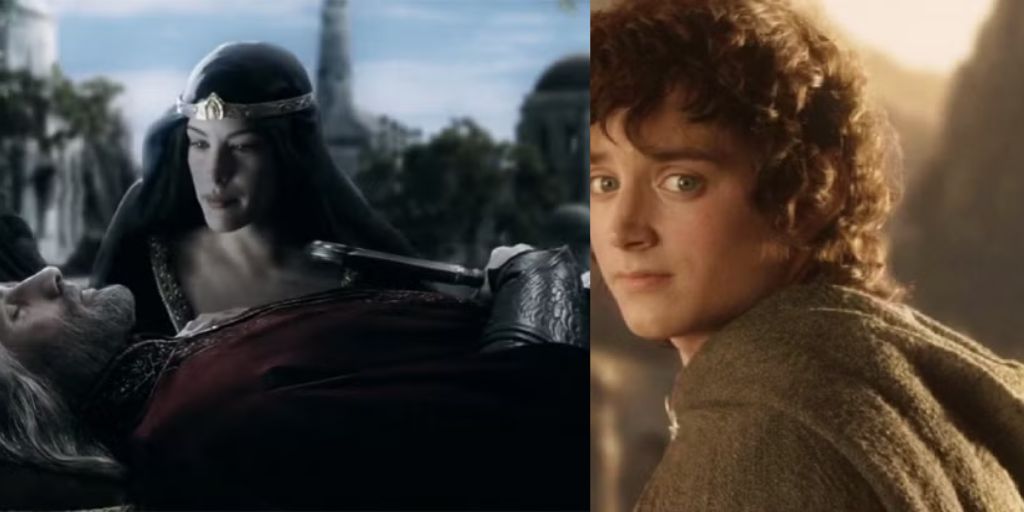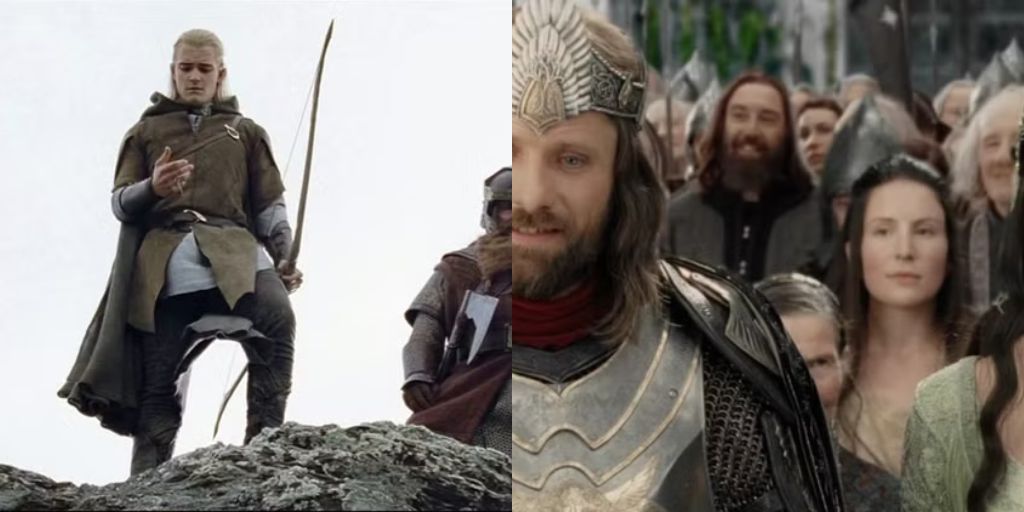When Gandalf (Ian McKellen) says, “I will not say do not weep, for not all tears are evil,” in The Lord of the Rings: The Return of the King, many viewers are already crying a lot.
This moment comes in the ending sequence of the third movie in Peter Jackson’s trilogy, which is both sad and hopeful.
It starts with Aragorn (Viggo Mortensen) becoming the king of Gondor and ends with Frodo (Elijah Wood) and Gandalf leaving Middle-earth behind for Valinor, a place for the Elves.
The Hobbits return to the Shire, and this marks the start of the Fourth Age. But what happens in Middle-earth after Sauron’s final defeat? Luckily, J. R. R. Tolkien shown more about Middle-earth’s future, explaining how the world moves on.
The Age of Men Begins with Aragorn as the New King of Gondor
In The Return of the King, Gondor is a kingdom that has lost its strength and is trying to keep its influence over the South. Boromir (Sean Bean) and Faramir (David Wenham) achieve great victories during the War of the Ring.
However, their father, Denethor (John Noble), the steward of Gondor, is not as eager as his sons to see Gondor regain its former glory.
After Denethor falls in the Battle of the Pelennor Fields, Aragorn steps up to take the throne. The situation calls for strong and inspiring leadership that only the true heir to the line of Elendil and Isildur can provide.
In the movies, Aragorn often hesitates about fulfilling his destiny as the heir to the throne of Gondor. However, in the books, this is a goal he thinks about from the beginning. He talks about it a lot, even when Boromir is by his side.
Regardless, Aragorn becomes the new king, the first Gondor has had in centuries since the line of Isildur was broken. As King Elessar, he marries the love of his life, Arwen (Liv Tyler).
Together, they have a son, Eldarion, and two daughters. Aragorn’s rule lasts for 120 years, and after that, Eldarion inherits the throne.
Aragorn’s reign is a time of peace and cooperation. He strengthens the bonds of Gondor with Rohan, which is now ruled by King Éomer (Karl Urban). The last remnants of Sauron’s influence in Rhûn and Harad are also defeated.
Aragorn even gives land by Lake Núrnen, which used to be part of Mordor, to the Easterlings so they can settle there and live peacefully. He also re-establishes the ancient realm of Arnor in the North. Aragorn becomes the High King of both Gondor and Arnor, ensuring protection for the Shire.
These actions help make the start of the Fourth Age a time of peace and prosperity, but it is unknown how long this will last, as Tolkien does not go into much detail about this in his writings.
The Dominion of Men Means Magic Slowly Fades from Middle-earth
In the Second Age, one main concern for the Elves was the fading of the Light of the Eldar, which symbolizes the magic that existed in Middle-earth at that time. To solve this problem and stop the Light from fading, they made the three Elven Rings, as seen in The Lord of the Rings: The Rings of Power.
These rings help the Elves keep their light from disappearing. However, all the Rings of Power are connected to the One Ring, which was forged by Sauron. Once the One Ring is destroyed in The Return of the King, the Rings of Power lose their abilities and become simple heirlooms from a time when magic was still alive in Middle-earth.
Because of this, the Elves, like Galadriel (Cate Blanchett) and Elrond (Hugo Weaving), must leave Middle-earth and go to the Undying Lands of Valinor. As the Light of the Eldar diminishes, places like Rivendell and Lórien slowly fade, becoming distant memories.
Other races, like the Dwarves and Hobbits, begin to disappear as well. Dwarves initially cooperate with Men, but a few centuries into the Fourth Age, they lose interest in surface affairs and keep to themselves in their mountain homes. The same goes for Hobbits. According to Tolkien, they still exist in the countryside but prefer to avoid any contact with humans.

As for the members of the Fellowship of the Ring, Samwise Gamgee (Sean Astin) marries Rosie Cotton (Sarah McLeod), and they have a large family. He, Merry (Dominic Monaghan), and Pippin (Billy Boyd) become mayors of their respective areas in the Shire and also serve as advisors to King Elessar.
Sam is eventually allowed into Valinor to spend the rest of his days with Frodo, while Merry and Pippin are laid to rest beside Aragorn in Minas Tirith. Legolas (Orlando Bloom) and Gimli (John Rhys-Davis) also leave for Valinor, making Gimli the only Dwarf permitted in the Undying Lands.
Tolkien’s World Continues All the Way into the Seventh Age
Thinking about Middle-earth after The Lord of the Rings is emotional. However, Tolkien makes it clear in his writings that these events are supposed to be the distant past of our own world. These events took place, and Arda (the world) continued after the Fourth Age.
In Letter 211 and in The Nature of Middle-earth, Tolkien concludes that the passing of the ages has “quickened,” meaning the world is now in the Seventh Age. What happens in the Fifth and Sixth Ages is unknown. Still, the ages of Middle-earth usually end with the defeat of a Dark Lord, which is a safe assumption.
An interesting part of Tolkien’s tales is the Athrabeth Finrod ah Andreth, a section in the book Morgoth’s Ring. This is a conversation between the Elf Finrod Felagund (played by Will Fletcher in The Rings of Power) and the human woman Andreth.
They debate topics like mortality and the nature of the divine. Finrod believes that understanding these issues is beyond Elves, Men, and even the Valar. Following that, Andreth mentions the ancient Edain prophecy of the Old Hope.
This is a deep belief that some humans have about a possible future intervention by Eru Ilúvatar (who is really God) to heal the world and fix the damage caused by Morgoth’s corruption. The prophecy says that one day, Eru might enter into Arda directly to bring about the redemption and restoration of the world.
This idea connects to Tolkien’s own Christian beliefs, especially the idea of incarnation—the belief that God could take human form to heal the world. This idea parallels the Christian understanding of Jesus Christ.
While the Athrabeth does not directly link this hope to any specific religious doctrine, Tolkien’s theological ideas subtly influence this vision of divine intervention.
He even came up with an alternative idea for the Apocalypse, called the Dagor Dagorath, after which the reshaping of Arda would take place. However, his son, Christopher Tolkien, mentions in Morgoth’s Ring that he later abandoned these ideas.
So, if we take Tolkien’s concept literally, it suggests that Middle-earth is still continuing, now as the world we live in. We are dealing with the corruption of Morgoth. Eru has already entered the world, and what happens next seems to be in our hands.
Life in Middle-earth After the War of the Ring
After the War of the Ring, life continues for many characters in Middle-earth. Each character faces new challenges and adventures in the peace that follows. The impact of Sauron’s defeat is felt throughout the lands, as old alliances are strengthened, and new friendships are formed.
In Gondor, Aragorn’s rule brings a time of renewal. He focuses on rebuilding the city and restoring its former glory. People feel a sense of hope, and the lands prosper under his guidance.
The people of Gondor enjoy peace, and trade increases with neighboring kingdoms. Aragorn also values the advice of his friends and allies, including Legolas and Gimli, who play important roles in the new kingdom.
In Rohan, King Éomer takes over after Théoden’s death. He works to strengthen ties with Gondor and protects his people from any remaining threats.
Éomer leads his riders into battle against any who dare to disrupt the peace. Under his rule, Rohan thrives, and its people celebrate their culture and traditions. The bond between Rohan and Gondor grows stronger as they work together to face any challenges.
In the Shire, life goes on in a peaceful manner. The Hobbits enjoy their simple pleasures. They plant gardens, tend to their farms, and hold celebrations.
Sam, Merry, and Pippin bring joy to the Shire. Sam raises a large family and becomes a respected leader in the community. He often shares stories of their adventures and inspires the younger generation.
The Dwarves and Their New Paths
The Dwarves, led by Gimli, continue their work in the mountains. They rebuild their homes and strengthen their defenses. Gimli becomes a bridge between Dwarves and Elves. His friendship with Legolas symbolizes a new era of cooperation between races. They show the beauty of Middle-earth together, creating a bond that lasts beyond their lifetimes.
As time passes, the Dwarves start to withdraw from the affairs of Men. They become more focused on their own communities and treasures. While they appreciate their past alliances, they choose to remain separate. The Dwarves find comfort in their mountain homes, crafting beautiful items and honoring their ancient traditions.
The Legacy of the Fellowship
The members of the Fellowship continue to honor their past and the sacrifices made during the War of the Ring. Sam carries the memory of Frodo and their journey to destroy the One Ring. He shares stories of bravery with his children and grandchildren. These tales become part of the Shire’s history.
Merry and Pippin also reflect on their adventures. They become respected leaders in their own right, guiding the Shire and making important decisions. They remain close friends with Sam and support each other through challenges.
Legolas and Gimli often return to the Shire to visit their friends. They share stories of their travels and adventures in other lands. Their friendship represents the unity between races and the importance of standing together against darkness.
The Fate of the Elves
As the Elves depart for Valinor, their absence leaves a significant impact on Middle-earth. Places once vibrant with magic start to fade. Rivendell and Lórien become quiet and distant memories. The beauty and wonder of the Elves’ magic slowly diminish, marking the end of an era.
Galadriel, Elrond, and other Elves find peace in the Undying Lands. They live in harmony, free from the worries of Middle-earth. However, their departure leaves a longing for the magic that once was.
The Future of Middle-earth
As Middle-earth continues into the Fourth Age, new challenges arise. While peace reigns, there are whispers of dark forces lurking in the shadows. The people remain vigilant, knowing that threats can emerge at any time. Aragorn, Éomer, and other leaders work together to ensure the safety of their lands.
Tolkien hints at the possibility of new adventures in the Fifth and Sixth Ages. The world evolves, and with it, the stories of its inhabitants. Although the details remain a mystery, the spirit of bravery and friendship continues to guide the people of Middle-earth.
Eru Ilúvatar and the Promise of Hope
Tolkien’s writings convey a deep sense of hope for the future of Middle-earth. The prophecy of the Old Hope suggests that divine intervention may come one day to heal the world. The belief in Eru Ilúvatar’s eventual return resonates with many characters in Tolkien’s tales. They hold onto the idea that goodness will triumph over evil.
This message reflects Tolkien’s own faith and belief in redemption. The struggles faced by the characters mirror the challenges faced by humanity. The journey of the Fellowship shows that hope exists even in the darkest times.
The Enduring Legacy of Middle-earth
The legacy of Middle-earth lives on in the hearts of its inhabitants. Stories of courage, friendship, and sacrifice continue to inspire future generations. The bonds formed during the War of the Ring create a sense of unity that lasts long after the battles have ended.
As the ages pass, the influence of the past shapes the future. The experiences of the characters serve as lessons for those who come after them. The themes of love, bravery, and resilience echo through time, reminding everyone that even in the face of adversity, hope endures.
Middle-earth Today
Today, the world may appear different, but the spirit of Middle-earth continues to exist. People live with the lessons learned from Tolkien’s tales. The struggles and triumphs of the characters remind us of our shared humanity.

Just like the heroes of Middle-earth, we face challenges and uncertainties. However, we can choose to stand together and support one another. The friendships and alliances formed in the stories remind us of the power of unity.
Conclusion: The Ongoing Journey of Middle-earth
As we reflect on the future of Middle-earth, we see that it is a world full of possibilities. The events following the War of the Ring show that life goes on, and new adventures await. The hope for redemption and healing remains a powerful theme in Tolkien’s works.
The legacy of the Fellowship, the resilience of the people, and the enduring magic of Middle-earth inspire us to embrace our journeys. Just as the characters faced their destinies, we too can shape our own futures.
The story of Middle-earth is not just a tale of the past; it is a reminder that we hold the power to create a better world, one filled with hope, courage, and love.





